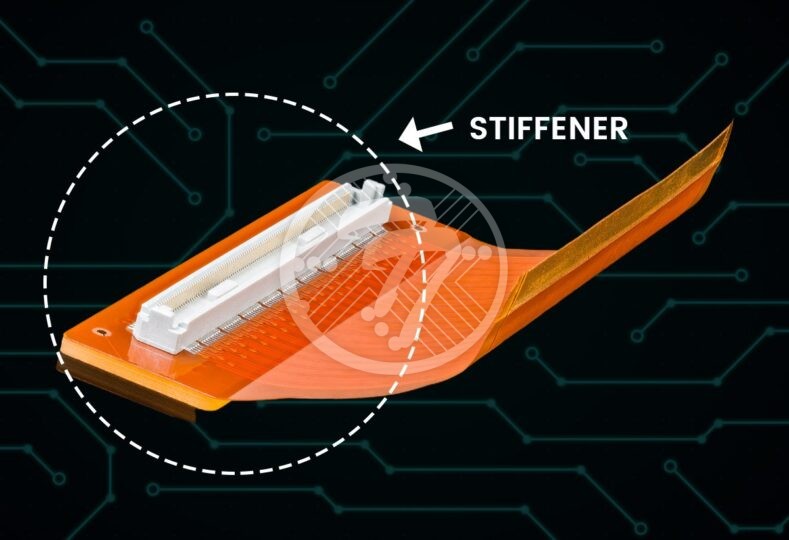The Complete Guide on Printed Circuit Board Stiffener for Rigid-Flex & Flex Circuits!

A printed circuit board stiffener plays an important role when it comes to offering mechanical support to a PCB. They are particularly helpful for flexible circuit boards, that given their name, are flexible and in need of stiffness in certain places.
Stiffeners are particularly required when components are placed in a flex zone & the weight of these components stresses the flex material. They are also of use where a rigid printed circuit boards surface needs to be created to place SMT pad components. Also, connectors that need multiple insertions need stiffeners so that the stress of the pads is reduced. Let us look at the uses of stiffeners in some more detail.
What are the various uses of PCB stiffeners?
Simply put a stiffener is used where a certain area of the circuit needs to be hardened. Here are some of the common reasons for which a stiffener is used:
- Supporting areas of the board that have SMT or PTH components.
- Maintaining legitimate thickness of the flex circuit.
- Supporting PCB connectors.
- Ensuring better handling of the circuit board.
- Ensuring that areas of the circuit board are kept stable.
- Helping in routing and retaining arrays.
- To help in strain relief as well as effective heat dissipation.
Broadly, flexible PCB stiffener requirements fall in the following usage categories:
- Rigidizing Component / Connector areas
- ZIF (Zero Insertion Force) Thickness Requirements
- Localized Bend Constraint(s)
Component / Connector Stiffeners
Essentially, they create a rigid area where components and connectors are attached. They also protect solder joints by ensuring the flex doesn’t bend in the component area.
ZIF Stiffeners
They ensure that the thickness is increased at contact fingers to meet specific ZIF connector specifications.
Localized Bend Constraints
They restrict bend areas to specific locations in a flex design.
How to select the right PCB stiffener material?
Typically, PCB stiffeners are made up of FR4 or rigid polyimide. One of the oft-used polyimides in PCB stiffeners is Kapton.
The thickness of a typical stiffener ranges from 0.002″ to 0.059″. The thickness of the Kapton stiffeners range from 0.002” to 0.010” and the thickness of the rigid stiffeners range from 0.008” to 0.059”. Broadly, of course the thicker the PCB stiffener, the better support it offers. However, the requirement of each design is different.
Some use cases also necessitate the use of stainless steel or aluminum as PCB stiffeners. The disadvantage with using those, of course, is the prohibitive cost.
How to use printed circuit board stiffeners?
In case of plated through-hole components, the PCB stiffener is located on the same side of the flex as the components. With this, access to solder pads on the flex circuit is easier.
It is also possible to attach stiffeners to both sides of a part however, in such cases the PCB assembly needs to go through an array configuration review.
When an assembly array is required for flex circuit designs, it is recommended to use the FR4 stiffener throughout the array border. By doing this, you eliminate the need for any additional tooling plates. Besides, it allows the parts to run through the automated assembly much like a rigid circuit board.
When it comes to attachment of a stiffener to a circuit, heat and pressure is used. A pressure-sensitive adhesive can also be used to attach PCB stiffeners.
Two popular types of adhesives include:
- Pressure Sensitive Adhesives
- Thermally Bonded Adhesives
To make the right selection of adhesives, some of the factors that need to be taken into account include:
- Thermal Exposure
- Chemical resistance
- Adhesive capacity when it comes to different materials.
PCB Stiffener Considerations
When using stiffeners, it is important to note that they should overlap bared coverlay by .030” to relieve stress. Also, when using multiple stiffeners, the same stiffener thickness should be maintained.
To sum up
The advantage of using a PCB stiffener when we need a rigid area in the circuit, in order to protect components or connectors, cannot be overstated. By doing so you can ensure that the circuit doesn’t bend and that the integrity of solder joints is protected. It is common to use FR4 as stiffener material for rigidizing specific areas of the circuit.
At Technotronix, we are fully equipped to handle your PCB manufacturing requirements. With over 4 decades of experience in rigid-flex PCBs with differing levels of complexities, our team of experts and state-of-the-art equipment ensure that all our PCBs meet the industry standards of quality and testing.
For more information, contact us via email at [email protected] or call us on 714/630-9200.






